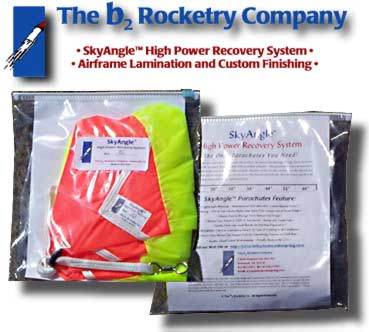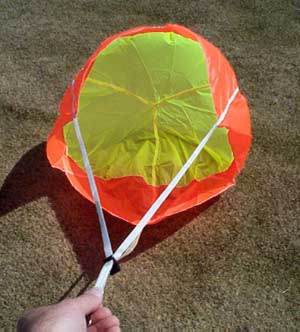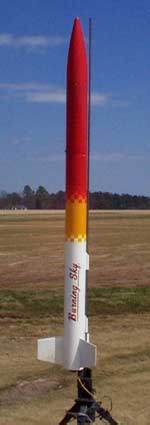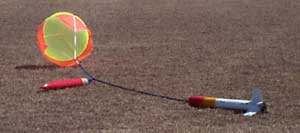B2 Rocketry Company SkyAngle Parachute
B2 Rocketry Company - SkyAngle Parachute {Component}
Contributed by Darrell Mobley
| Manufacturer: | B2 Rocketry Company  |

b2 Rocketry's NEW 'SkyAngle' Parachutes!
 Savannah, Georgia
-- Competition has always bred innovation and consequently innovation has led
technology. Given such, new technology is indeed brewing in this Southeastern
Georgia town, in the form of innovative recovery devices. Savannah, Georgia,
USA is the home of Mike and Pam Barton, makers of the new
"SkyAngle™" line of parachutes, and owners of the company,
b2 Rocketry Company.
Savannah, Georgia
-- Competition has always bred innovation and consequently innovation has led
technology. Given such, new technology is indeed brewing in this Southeastern
Georgia town, in the form of innovative recovery devices. Savannah, Georgia,
USA is the home of Mike and Pam Barton, makers of the new
"SkyAngle™" line of parachutes, and owners of the company,
b2 Rocketry Company. Currently offered in six stock sizes, the SkyAngle™ features some unique design concepts. The SkyAngle™ is a very high-quality parachute that was designed specifically for the needs of the serious high power rocketry enthusiast. Sturdy and light, it is fabricated to provide maximum "braking capacity" to bring your birds safely home while minimizing the long walks associated with excessive drift. A special characteristic of this system is that it tends to rotate during descent. This helps dissipate potential energy inherent in the fall and provides for a stable recovery. The addition of an exclusive 1000 pound test swivel assembly ensures a virtually tangle-free landing!

Rocketry Online asked Mike and Pam if we could test their new parachute at the recent Mick Wilkins Memorial Sport Scale Launch in Perry, Georgia, and was supplied with a 36" SkyAngle™ parachute. The SkyAngle™ is unique, as seen in the photo to the left, in that even though it's advertised as a 36" parachute, the canopy actually measures nearly 72" from "tip-to-tip", almost doublt the fabric surface of a simple 36" circular parachute!
You will also notice the presence of just three shroud lines, made of 950 pound test, military-spec tubular nylon, circling the canopy and sewn in a continuous path around the outside of the canopy with polyester monofiliment sail maker's thread, which adds considerable strength to the structure. At the lower end of the shroud lines you will also notice the line reefer, utilizing a metal-free design which won't rust and break over time. These simple, yet innovative features reduce tangling substantially.
We flew the SkyAngle™ in my venerable LOC/Precision EZI-65, which has more flights logged than the rest of my fleet combined. While this flight vehicle has been retro-fitted with a dual-deployment recovery system, I opted to fly the EZI with just a main chute to compare it to a stock EZI, as they come standard with 36" chutes.
 Named
"Burning Sky", this launch vehicle has served as my Level 1 and Level
2 certification machine. The only near-disaster it has endured was an incorrect
delay during an I-161 flight in Dallas, Texas, where the tubular nylon wrinkled
the upper body tube opening during the early deployment. During the repair, I
lengthened the main body tube 6" and the dual-stage deployment system
added about 4" to the lower end of the payload section, adding about
10" overall the length of the EZI.
Named
"Burning Sky", this launch vehicle has served as my Level 1 and Level
2 certification machine. The only near-disaster it has endured was an incorrect
delay during an I-161 flight in Dallas, Texas, where the tubular nylon wrinkled
the upper body tube opening during the early deployment. During the repair, I
lengthened the main body tube 6" and the dual-stage deployment system
added about 4" to the lower end of the payload section, adding about
10" overall the length of the EZI.
For this flight, I utilized an AeroTech I-211 RMS reloadable motor, predicting an overall altitude of about 2000 feet, more than sufficient to examine the characteristics of the SkyAngle™ parachute. In addition to the Adept ALTS-2 altimeter, I provided for redundant backup by relying on a medium delay in the motor.
Launched on the first day of the event, Saturday, March 14th, the weather was a beautiful 60+ degrees with clear skies. The wind was less favorable that all the abundant sunshine, gusting from 5-15 miles per hour during the day. This would provide for interesting test conditions indeed! It would be a first hand opportunity to witness the recovery system exposed to above average winds, and to compare how the induced spin of the parachute worked in relationship to the oscillation of the rocket.
For those of you who haven't had the opportunity to launch from Tripoli Atlanta's launch site, it is a 400 acre sod farm which is used to grow seed early in the season and stripped of the sod later in the season. The site is akin to having a 400 acre front yard! Ejected motor casings, etc. are very easy to locate on the short level plane of the grass. Consequently, recovering your rocket after a flight is an easy stroll in the direction of descent, with virtually no obstacles in your recovery path.
 The
rocket lifted to 2121 feet, weathercocking slighting into the wind, climbing
away on its tail of fire. At apogee it ejected the SkyAngle™ parachute on
cue, immediately it filled with air and then began its journey back to terra
firma. Descent was very steady, without the slightest bit of oscillation, with
no appearance of recovery line tangle what-so-ever. The slight rotation built
into the parachute appeared to dampen oscillation and induced a smooth
recovery.
The
rocket lifted to 2121 feet, weathercocking slighting into the wind, climbing
away on its tail of fire. At apogee it ejected the SkyAngle™ parachute on
cue, immediately it filled with air and then began its journey back to terra
firma. Descent was very steady, without the slightest bit of oscillation, with
no appearance of recovery line tangle what-so-ever. The slight rotation built
into the parachute appeared to dampen oscillation and induced a smooth
recovery.
The rocket touched down lightly into the short grass with no evidence of damage. Inspection of the parachute revealed no damage to it as well, all-in-all it appears the product is everything the manufacturer said it was -- definitely two thumbs up!
You should take a closer look at this company and their products. The "SkyAngle" is a great product and should be considered for your recovery system choiced. Available in six sizes, between 20" and 60", they are sure to have what you are looking for. For more information, check out their web site at http://b2rocketry.home.mindspring.com/index.html.
Written and submitted by Darrell D. Mobley for Rocketry Online -- Copyright 1996-1999
Other Reviews
- B2 Rocketry Company SkyAngle Parachute By Bob Thompson and Sunny Sisk
The following article is from "High Power Rocketry" magazine. This information represents only a small portion of the contents of "High Power Rocketry". We strongly suggest that you subscribe to "High Power Rocketry". By doing so you will find many color pictures, articles, launch reports and projects primarily associated with High Power Rocketry activities. For more information, use ...
 |
 |
Sponsored Ads
 |
 |












K.G. (May 30, 2003)